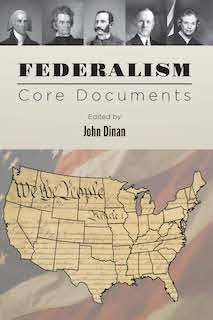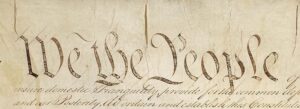
What Documents Should I Teach? Federalism, with John Dinan
John Dinan is the editor of our latest CDC volume, Federalism. He sat down with Ellen Tucker to discuss how teachers can use the volume in their government or civics classrooms.
If a teacher were to say to you, I’ve got time to use only two or three documents from your collection in my one-semester government class, which documents would you suggest the teacher select?
It depends on what your goals are for the course. I studied federalism under Professor Martha Derthick at the University of Virginia. She said federalism is a very large elephant, and it’s hard for a lone observer to grasp the properties of the whole beast. If you want to study federalism, you have to look at what the Supreme Court is doing. Then you have to look at what the presidents are doing. Then, what Congress is doing. You must study political party platforms, and you have to look at policy.
But first of all, if you want to understand the intention of the framers of the Constitution in setting up a federal system, and their expectations for how it would work, I would select Federalist 39 (Document 4). Here, Publius—Madison in this case—sets out his expectations for the balance of power between the federal and state governments. Then I would choose an Antifederalist selection, most likely Patrick Henry’s speech in the Virginia ratifying convention (Document 7), in which he explains why he fears that under the new Constitution, all power would eventually flow to the federal government.
Suppose I really want to focus on whether federalism has been seen as beneficial to the United States. I would likely pick Louis Brandeis’ dissenting opinion in the 1932 Supreme Court case, New State Ice Company v. Liebmann(Document 31). I would consider assigning the Kestnbaum Commission Report from the 1950s (Document 34). And I would also consider assigning Justice Sandra Day O’Connor’s opinion in the Gregory v. Ashcroft decision in 1991 (Document 41), where she concisely summarizes advantages of the American federal system that she believes are still operating.
In any course taking up the role of the Supreme Court, students will want to understand how the Supreme Court has shaped the balance between federal and state powers. There are a number of court decisions excerpted in the volume. One can easily locate them by consulting the thematic table of contents, Appendix B in the volume, under the heading “The US Supreme Court and Federalism.” I would consider assigning the Dobbs v. Jackson Women’s Health decision (Document 45). Although it’s very much about abortion, it’s also very much about federalism. The whole question was, should abortion policy be determined at the state or federal level? One might also consider the Supreme Court opinion on the constitutionality of the Affordable Care Act (Document 43), President Obama’s signature health care policy. It’s a wide-ranging decision, and it gets technical, but for the most part the ruling dissects what aspects of health care are the responsibility of the federal government and which are the responsibilitiy of the states.
We often—probably too often today—think about American politics through the lens of the presidency. Nine of the documents in this collection illustrate presidential thinking about federalism. Several show presidents vetoing acts of Congress that they maintained violated the American understanding of federalism. President James K. Polk vetoed an act of Congress (Document 19) providing funding to make navigation improvements to rivers and harbors in some of the states. He objected that Congress had no right to fund projects that were “local in character.” President James Buchanan in the 1850s vetoed a bill that would have allowed the federal government to donate land to states for use as college sites (Document 20). Buchanan thought the federal government had no business supporting state educational facilities. These instances show a view on the part of some of our earlier presidents that it was their duty to superintend the federal system.
When teaching political science and government, we tend to teach federalism and the separation of powers as one issue, and to teach civil rights and liberties as a separate issue. Yet the two issues are very often intertwined. A number of the readings in the document book center on the question whether civil liberties are better protected when the states wield certain powers or when the federal government wields them. Do we do need a uniform national understanding of our rights as citizens? That’s been the case in various understandings of what it means to get a fair trial in the United States. For many years, states were allowed to decide whether or not they would exclude evidence if it was improperly seized by police. Some states excluded such evidence, while other states said, “Well, the damage is already done. We don’t want to prevent the jury from hearing about that.” It was not until the 1960s that the US Supreme Court imposed one uniform understanding of that. They decided that evidence improperly seized cannot be used in a trial.
Supreme Court Justice William Brennan wrote a famous Harvard Law Review article in 1977 (excerpted in the volume as Document 38). He said, we tend to think of our rights as being protected by the US Constitution, with the constitutional oversight of the US Supreme Court. Yet all 50 states have their own constitutions, which are interpreted by state courts. Through these means, states may in fact provide greater protection for rights than is guaranteed by the federal Constitution. And in fact, today we see some state constitutions being amended or interpreted to explicitly protect abortion rights. Even though the US Supreme Court said they didn’t see a right to abortion guaranteed in the US Constitution, Justice Brennan makes clear that this is not the end of the story. In some cases, state constitutions and state courts provide a higher level of rights protection than might be granted uniformly.
In general, I hope teachers use this document book to open up the question of whether or not American citizens benefit from our federal system. The study questions at the end of the volume should help teachers and students reflect on this: whether, in the circumstances we face today, our federal system still protects our liberties and promotes good government.




